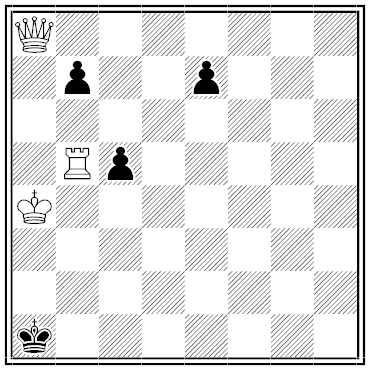Author: Greg Ross
In a Word
frustraneous
adj. useless; unprofitable
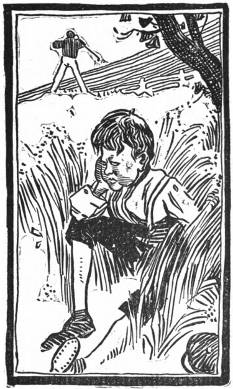
One Day a Caddy sat in the Long Grass near the Ninth Hole and wondered if he had a Soul. His Number was 27, and he almost had forgotten his Real Name.
As he sat and Meditated, two Players passed him. They were going the Long Round, and the Frenzy was upon them. They followed the Gutta Percha Balls with the intent swiftness of trained Bird Dogs, and each talked feverishly of Brassy Lies, and getting past the Bunker, and Lofting to the Green, and Slicing into the Bramble — each telling his own Game to the Ambient Air, and ignoring what the other Fellow had to say.
As they did the St. Andrews Full Swing for eighty Yards apiece and then Followed Through with the usual Explanations of how it Happened, the Caddy looked at them and Reflected that they were much inferior to his Father.
His Father was too Serious a Man to get out in Mardi Gras Clothes and hammer a Ball from one Red Flag to another.
His Father worked in a Lumber Yard.
He was an Earnest Citizen, who seldom Smiled, and he knew all about the Silver Question and how J. Pierpont Morgan done up a Free People on the Bond Issue.
The Caddy wondered why it was that his Father, a really Great Man, had to shove Lumber all day and could seldom get one Dollar to rub against another, while these superficial Johnnies who played Golf all the Time had Money to Throw at the Birds. The more he Thought the more his Head ached.
MORAL: Don’t try to Account for Anything.
— George Ade, Fables in Slang, 1899
Math Notes
10989 × 9 = 98901 × 1
21978 × 8 = 87912 × 2
32967 × 7 = 76923 × 3
43956 × 6 = 65934 × 4
54945 × 5 = 54945 × 5
Specialists
In 1970 Dmitri Borgmann and Dwight Ripley compiled a list of “missing words” — foreign words with complex or interesting meanings that have no counterparts in English. I can’t immediately confirm most of these, but they’d certainly be useful words:
DENTERA (Spanish): a setting of the teeth on edge
PAPABILE (Italian): having some chance of becoming Pope
PIECDZIESIECIORUBLOWY (Polish): costing fifty rubles
PREDSVATEBNY (Czech): taking place on the eve of a wedding
KWELDER (Dutch): land on the outside of a dike
EZERNYOLCSZAZNEGYVENNYOLCBAN (Hungarian): in 1848
PASAULVESTURISKS (Lettish): of worldwide significance
MIHRAP (Turkish): a woman still beautiful though no longer young
UBAC (Provençal): the sunless north side of a mountain
HARFENDAZ (Turkish): one who makes insulting remarks to women in the street
PENCELESMEK (Turkish): to lock fingers with another and have a test of strength
MEZABRALIS (Lettish): a revolutionary hiding in a forest
MATAO (Brazilian Portuguese): a jockey who crowds the others against the fence
NEMIMI (Japanese): the ears of one sleeping
YOKOTOJI (Japanese): bound so as to be broader than long — said of a book
TOADEIRA (Portuguese): a harpooned whale that continues to sound
In 2006 the Goethe Institute held a competition to find German words that deserve a place in English. The winner was Fachidiot, literally “subject idiot,” a scholar blinkered by long study: “A one-track specialist still notices what is going on around him in the world which has nothing to do with university. A Fachidiot simply does not, or not anymore.” Runners-up included Backpfeifengesicht, “a face which invites you to slap it”; Kummerspeck (literally, “grief bacon”), “excessive weight gain caused by emotion-related overeating”; and Torschlusspanik (“gate closing panic”), the fear that time is running out to act.
(Dmitri Borgmann, “Missing Words,” Word Ways 3:1, February 1970.)
Advancement
From the diary of Wilfrid Scawen Blunt, Nov. 20, 1898:
To luncheon at Malwood. Sir William in excellent form, principally about the bishops, with whom he is now in violent conflict. He narrated to us a conversation he had had with the Duke of Devonshire as to the nomination to a bishopric. The Duke’s account of it was this: ‘He had written two letters to Salisbury, recommending a fellow, he couldn’t remember the fellow’s name, and Salisbury hadn’t even answered. He had written because Courtney and another fellow, he couldn’t remember his name either, had wanted it.’ On inquiry it had turned out that the proposed nominee was Page Roberts, and Sir William had taken an opportunity of asking Lord Salisbury why he hadn’t made Page Roberts a bishop. ‘The fact is,’ said Salisbury, ‘I thought they were talking of Page Hopps, and we gave it to some one else.’ ‘That,’ said Sir William, ‘is the way they make bishops.’
No Tabs
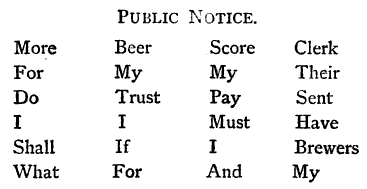
William West noticed this inscription in an alehouse near Brighton. What does it mean?
Pedal Pusher

Inventor Warren C. Schroeder offered a novel energy saver in 1981 — a sail for bicycles:
[The] sail … can be erected, dismantled or removed in seconds and … can take advantage of the wind direction in an arc that exceeds 200 degrees. The sail can be reoriented by the operator from the bicycle seat while in operation of the cycle. This allows operator to take full advantage of the full effective wind directional range and change. The use of the sail improves visibility of the bicycle from other vehicle operators thereby improving the safety of the cyclist.
“The bicycle sail allows the cycle enthusiast an inexpensive means of free transportation energy — the wind, ‘sailing on wheels.'” Stopping may be another matter.
Correlation, Causation
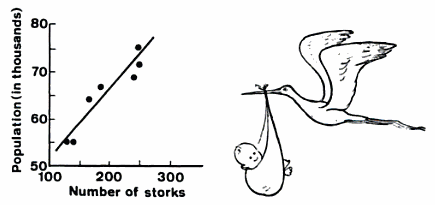
From Richard F. Mould’s Introductory Medical Statistics — this graph plots the population of Oldenburg, Germany, at the end of each year 1930-1936 against the number of storks observed in that year.
Does this explain the storks’ presence? Not necessarily: In 1888 J.J. Sprenger noted, “In Oldenburg there is a curious theory that the autumnal gatherings of the storks are in reality Freemasons’ meetings.”
Digit Work
A useful system of finger reckoning from the Middle Ages:
To multiply 6 x 9, hold up one finger, to represent the difference between the 5 fingers on that hand and the first number to be multiplied, 6.
On the other hand, hold up four fingers, the difference between 5 and 9.
Now add the number of extended fingers on each hand to get the first digit of the answer (1 + 4 = 5), and multiply the number of closed fingers on each hand to get the second (4 × 1 = 4). This gives the answer, 54.
In this way one can multiply numbers between 6 and 9 while knowing the multiplication table only up to 5 × 5.
A similar system could be used to multiply numbers between 10 and 15. To multiply 14 by 12, extend 4 fingers on one hand and 2 on the other. Add them to get 6; add 10 times that sum to 100, giving 160; and then add the product of the extended fingers, 4 × 2, to get 168.
This system reflects the fact that xy = 10 [(x – 10) + (y – 10)] + 100 + (x – 10)(y – 10).
(From J.T. Rogers, The Story of Mathematics, 1968.)
Succinct
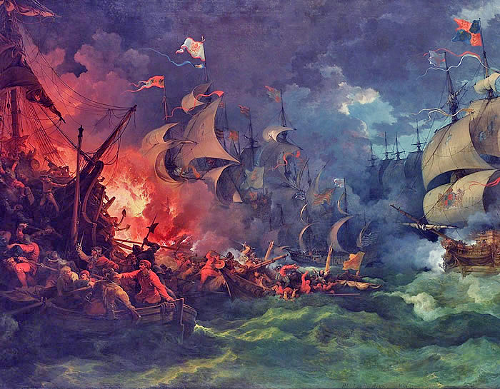
Pun fans claim that Sir Francis Drake reported the defeat of the Spanish Armada with a single word: “Cantharides” (an aphrodisiac; hence “The Spanish fly”).
When Sir Charles Napier took the Indian province of Sindh in 1843, he supposedly sent a one-word report to the British war office: Peccavi (Latin for “I have sinned”).
When Lord Dalhousie annexed Oudh in the 1850s, he’s said to have sent a dispatch of a single word: Vovi (I vowed, or “I’ve Oudh”).
And when Lord Clyde captured Lucknow in 1857, he supposedly reported, “Nunc fortunatus sum.”
A dinner guest once bet her friends that she could get Calvin Coolidge to say at least three words during the meal. He told her, “You lose.”
(Thanks, Ted.)

